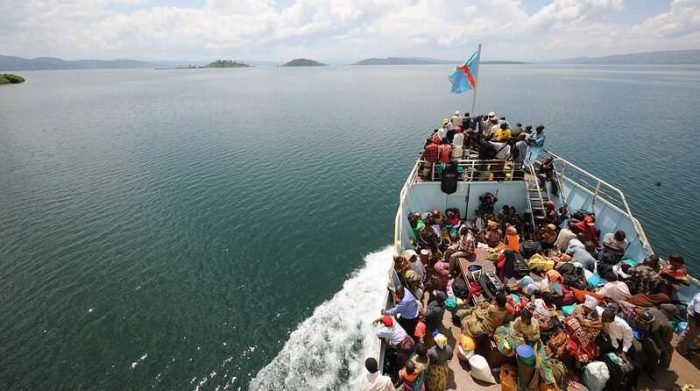Space not available
The file format is not recognized
Reserve this advertising space
Post an ad : banner or video
press release, interview, sponsorship
Choose this advertising space
and click here to transmit
an announcement file
Your ad in pop-up format
Choose this advertising space
and click here to transmit
an announcement file
a file
or
Transmit here
a file
– Revitalize maritime and river transport

The DRC has a maritime, river, and lake network of 16,238 km of waterways to be marked, dredged, and exploited. The construction of the deep-water port of Banana on the Atlantic coast will be the country's first major economic infrastructure.
Space not available
The file format is not recognized
Reserve this advertising space
Post an ad : banner or video
press release, interview, sponsorship
Choose this advertising space
and click here to transmit
an announcement file
Your ad in pop-up format
Choose this advertising space
and click here to transmit
an announcement file
a file
or
Transmit here
a file
Numerous inland ports are located alongside the three seaports of Matadi, Boma and Banana in Muanda.
As one of the continent's largest mineral exporters, the DRC lacks a port facility worthy of the name to facilitate the evacuation of mining industry output. This forces operators to transport some of the extracted resources through the neighboring ports of Dar es Salaam (Tanzania) or Lobito (Angola). The launch of work on the Banana deepwater port complex in central Kongo in early 2022 will meet this demand following the signing of two new agreements between the Congolese government and the Emirati group DP World, which was awarded the concession for the port.
Banana is the only town in the DRC with access to the Atlantic Ocean. The country, which, with only 37 km of oceanfront, is semi-landlocked, has opted to capitalize on this asset through this port project in order to consolidate its supply chain.
This port complex, which will be developed in four phases, will require a total investment of 1.2 billion $. The first phase of the project, which will cost 350 million $, consists of building a 600 m² quay and 25 hectares of storage space, with an annual capacity of 322,000 containers and more than 1.3 million tons of goods. This first phase, scheduled for completion in 2025, will allow large container ships to dock. This will be the DRC's first major economic infrastructure on the Atlantic, a project that dates back more than 80 years, but which had, until now, never seen the light of day. The port of Banana consisted of a single quay approximately 75 meters long, in a bay, slightly away from the main course of the river. A rudimentary space capable of accommodating only boats with a draft of less than five meters. Storage was limited to a 2,500 m² warehouse.
This infrastructure, expected to play a key role in the Congolese economy, will, among other things, reduce the country's dependence on neighboring states for its maritime freight. DP World has been awarded a 30-year concession to recoup the investment.
Pending the construction of the Banana port, the port of Matadi continues to be the main logistics hub in the DRC's supply chain. With the help of donors, the government is focusing on strengthening its capacity to meet the challenge of increasing volumes.
The DRC has received a grant of 18 million $ from the Japan International Cooperation Agency (JICA) to carry out rehabilitation work at the port of Matadi. The funding, granted to the Société Commerciale des Transports et des Ports (SCTP), will be used to rehabilitate the container storage area in the container yard and its associated facilities; improve the safety of container handling operations by improving the container yard's surfacing; and introduce a Terminal Operating System (TOS) at the port of Matadi. The project will help anticipate forecasts that predict an increase in traffic that could double the platform's current capacity by 2030.
Built on the left bank of the Congo River, the port of Matadi, currently the largest port platform in the DRC, is built with limited capacity nautical facilities.
Space not available
The file format is not recognized
Reserve this advertising space
Post an ad : banner or video
press release, interview, sponsorship
Choose this advertising space
and click here to transmit
an announcement file
Your ad in pop-up format
Choose this advertising space
and click here to transmit
an announcement file
a file
or
Transmit here
a file
The major river ports are the ports of Ilebo, Kisangani, Mbandaka, Bumba, Ubundu, Kindu, and Kinshasa. The major lake ports include the ports of Kalemie, Kalundu, and Mushimbakye in Baraka. Built during the colonial era and not upgraded since, almost all of these ports operate at low efficiency, and some are no longer functional at all, such as the Port of Bumba or that of Mushimbakye.
The low performance of these ports is explained both by the poor state of the waterways: 9,000 km are not marked and 7,238 km are only partially marked, making almost 80% of the river network impassable, and by the dilapidation and the shutdown of almost all the boats that served them.
The main river project involves the deployment of ferries to facilitate the crossing between the DRC and the Central African Republic, separated by the Oubangui River.
The Congolese government will also relaunch urban river transport services in Kinshasa. The initiative is part of a series of measures planned to alleviate the hardships caused by heavy traffic congestion in the Congolese capital.
The President of the Republic, Félix Tshisekedi, wishes to rethink the strategy of the Congolese Maritime Line by providing it, in particular, with efficient and suitable vessels to enable it to play its natural role of arming the State, based on the observation that this public company has to date gone more than two decades without having its own fleet.
A recovery plan should focus, in particular, on the floating units to be rehabilitated in the existing parks, but also on revaluing local industry, including the SCTP and Chanimétal shipyards for the construction of new units according to relevant standards, in order to serve both the river and its tributaries.
At the same time, since 2020, the DRC has decided to close the illegal private ports that are proliferating across the country. In addition to regulation, these ports generate enormous losses for the Société commerciale des Transports et Ports (SCTP), a state-owned entity that should, in principle, handle 90% of Congolese maritime freight.
The rebirth of the Kinshasa-Brazzaville bridge
On June 22, 2022, the Minister of Planning, Christian Mwando Nsimba Kabulo, and his counterpart from the Republic of Congo, in charge of Planning, Territorial Equipment and Major Works, Jean-Jacques Bouya, signed a call for expressions of interest for an international call for tenders to select a partner for the project to finance, build and operate the road-rail bridge over the Congo River between Kinshasa and Brazzaville, a major infrastructure project on Africa's second-longest river, linking the two closest capitals in the world. Traffic is expected to increase to more than three million people and two million tons of freight by 2025.
With an estimated population of around 15 million, the city of Kinshasa faces significant challenges related to its demographic, economic, social and infrastructure development, including housing, transportation, and many other areas. Thus, since August 2015, the city of Kinshasa has had a general planning document called the Strategic Orientation Scheme for the Kinshasa Agglomeration (SOSAK), along with a specific development plan for the North PPA Zone.
Space not available
The file format is not recognized
Reserve this advertising space
Post an ad : banner or video
press release, interview, sponsorship
Choose this advertising space
and click here to transmit
an announcement file
Your ad in pop-up format
Choose this advertising space
and click here to transmit
an announcement file
a file
or
Transmit here
a file
















 A Seat That Transforms into a Bed
A Seat That Transforms into a Bed  In the world of air travel, economy class is often considered the most affordable option. However, at Air Afrika, we believe that affordability shouldn't mean compromising on quality of service. Our class
In the world of air travel, economy class is often considered the most affordable option. However, at Air Afrika, we believe that affordability shouldn't mean compromising on quality of service. Our class











